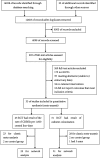Effectiveness of antimicrobial-coated central venous catheters for preventing catheter-related blood-stream infections with the implementation of bundles: a systematic review and network meta-analysis
- PMID: 29904809
- PMCID: PMC6002334
- DOI: 10.1186/s13613-018-0416-4
Effectiveness of antimicrobial-coated central venous catheters for preventing catheter-related blood-stream infections with the implementation of bundles: a systematic review and network meta-analysis
Abstract
Background: Catheter-related blood-stream infections (CRBSIs) are the most common complication when using central venous catheters (CVCs). Whether coating CVCs under bundles could further reduce the incidence of CRBSIs is unclear. We aimed to assess the effectiveness of implementing the use of bundles with antimicrobial-coated CVCs for preventing catheter-related blood-stream infections.
Methods: In this systematic review and network meta-analyses, we searched the Cochrane Central Register of Controlled Trials (CENTRAL) in the Cochrane Library in addition to the EMBASE, MEDLINE, CINAHL, and Web of Science databases for studies published before July 2017. The primary outcome was the rate of CRBSIs per 1000 catheter-days, and the secondary outcome was the incidence of catheter colonization.
Results: Twenty-three studies revealed significant differences in the rate of CRBSIs per 1000 catheter-days between antimicrobial-impregnated and standard CVCs (RR 0.70, 95% CI 0.53-0.91, p = 0.008). Thirty-three trials were included containing 10,464 patients who received one of four types of CVCs. Compared with a standard catheter, chlorhexidine/silver sulfadiazine- and antibiotic-coated catheters were associated with lower numbers of CRBSIs per 1000 catheter-days (ORs and 95% CrIs: 0.64 (0.40-0.955) and 0.53 (0.25-0.95), respectively) and a lower incidence of catheter colonization (ORs and 95% CrIs: 0.44 (0.34-0.56) and 0.30 (0.20-0.46), respectively).
Conclusions: Outcomes are superior for catheters impregnated with chlorhexidine/silver sulfadiazine or other antibiotics than for standard catheters in preventing CRBSIs and catheter colonization under bundles. Compared with silver ion-impregnated CVCs, chlorhexidine/silver sulfadiazine antiseptic catheters resulted in fewer cases of microbial colonization of the catheter but did not reduce CRBSIs.
Keywords: Bundles; Catheter colonization; Catheter-related blood-stream infections; Central venous catheter; Meta-analysis.
Figures




Similar articles
-
Effectiveness of silver-impregnated central venous catheters for preventing catheter-related blood stream infections: a meta-analysis.Int J Infect Dis. 2014 Dec;29:279-86. doi: 10.1016/j.ijid.2014.09.018. Epub 2014 Nov 6. Int J Infect Dis. 2014. PMID: 25447733 Review.
-
Rifampicin-impregnated central venous catheters: a meta-analysis of randomized controlled trials.J Antimicrob Chemother. 2007 Mar;59(3):359-69. doi: 10.1093/jac/dkl522. Epub 2007 Jan 25. J Antimicrob Chemother. 2007. PMID: 17255143
-
New choices for central venous catheters: potential financial implications.Chest. 2003 Jul;124(1):275-84. Chest. 2003. PMID: 12853534 Clinical Trial.
-
The effectiveness of chlorhexidine-silver sulfadiazine impregnated central venous catheters in patients receiving high-dose chemotherapy followed by peripheral stem cell transplantation.Eur J Cancer Care (Engl). 2009 Sep;18(5):477-82. doi: 10.1111/j.1365-2354.2008.00964.x. Eur J Cancer Care (Engl). 2009. PMID: 19453696
-
Prevention of bloodstream infections with central venous catheters treated with anti-infective agents depends on catheter type and insertion time: evidence from a meta-analysis.Infect Control Hosp Epidemiol. 2002 Dec;23(12):748-56. doi: 10.1086/502005. Infect Control Hosp Epidemiol. 2002. PMID: 12517018
Cited by
-
Dibasic Derivatives of Phenylcarbamic Acid as Prospective Antibacterial Agents Interacting with Cytoplasmic Membrane.Antibiotics (Basel). 2020 Feb 6;9(2):64. doi: 10.3390/antibiotics9020064. Antibiotics (Basel). 2020. PMID: 32041117 Free PMC article.
-
Prevention of medical device infections via multi-action nitric oxide and chlorhexidine diacetate releasing medical grade silicone biointerfaces.J Biomed Mater Res A. 2022 Jun;110(6):1263-1277. doi: 10.1002/jbm.a.37372. Epub 2022 Feb 15. J Biomed Mater Res A. 2022. PMID: 35170212 Free PMC article.
-
Perioperative anaphylaxis: an update on pathophysiology, diagnosis, and management.Can J Anaesth. 2025 Apr;72(4):649-674. doi: 10.1007/s12630-025-02915-5. Epub 2025 Apr 17. Can J Anaesth. 2025. PMID: 40244358 Review. English.
-
Recent Developments in Multifunctional Antimicrobial Surfaces and Applications toward Advanced Nitric Oxide-Based Biomaterials.ACS Mater Au. 2022 Sep 14;2(5):525-551. doi: 10.1021/acsmaterialsau.2c00040. Epub 2022 Aug 8. ACS Mater Au. 2022. PMID: 36124001 Free PMC article. Review.
-
[Update of the recommendations of the Bacteraemia Zero Project].Enferm Intensiva. 2022 Sep;33:S31-S39. doi: 10.1016/j.enfi.2022.06.002. Epub 2022 Jul 26. Enferm Intensiva. 2022. PMID: 35911623 Free PMC article. Review. Spanish.
References
-
- Vaquero SE, Izquierdo GE, Arrizabalaga AM, Gómez PC, Moreno JVJM. Blood-stream catheter related infection in inpatient children receiving parenteral nutrition. Nutr Hosp. 2011;26:236–238. - PubMed
-
- Rosenthal VD, Al-Abdely HM, El-Kholy AA, AlKhawaja SA, Leblebicioglu H, Mehta Y, et al. International Nosocomial Infection Control Consortium report, data summary of 50 countries for 2010–2015: device-associated module. Am J Infect Control. 2016;44:1495–1504. doi: 10.1016/j.ajic.2016.08.007. - DOI - PubMed
-
- Hu B, Tao L, Rosenthal VD, Liu K, Yun Y, Suo Y, et al. Device-associated infection rates, device use, length of stay, and mortality in intensive care units of 4 Chinese hospitals: international Nosocomial Control Consortium findings. Am J Infect Control. 2013;41:301–306. doi: 10.1016/j.ajic.2012.03.037. - DOI - PubMed
Publication types
Grants and funding
LinkOut - more resources
Full Text Sources
Other Literature Sources
Medical

